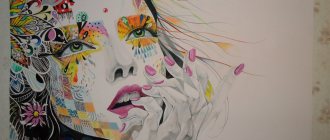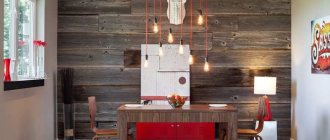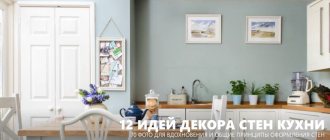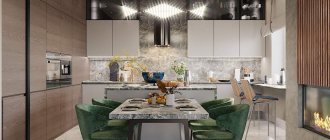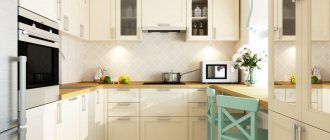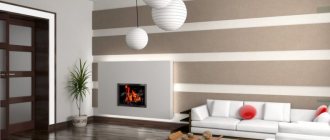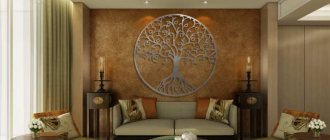Geometric patterns on the walls
Straight lines, circles, squares and diamonds have already become classics in interior design. This technique can easily visually change the proportions of a room.
Horizontal stripes make ceilings higher. To implement straight lines, the easiest option is wallpaper. If the wall is ready for painting, then using masking tape it will not be difficult to make straight lines and fill them with paint. It is important to clearly understand what you want to see as a result.
In a children's room, you can draw mountains from clear geometric lines using pastel colors. Snow on the peaks can also be drawn with straight lines.
To create coziness in the bedroom behind the bed, draw a circle in warm colors. You can implement this idea yourself using a needle, thread and pencil. The main thing is to correctly calculate the proportions depending on the headboard. Hang a shelf above the bed with climbing plants on it.
If you are using a stencil
Finding a stencil will not be difficult for you; you can find and print any design on the Internet. You will need to cut it out, place it on a glass surface.
Then take the Mylar film, apply it to the stencil and cut it out. After this, the stencil can be attached to the wall. You can even use a paper stencil. It needs to be pressed down tightly or you risk smearing the entire design on the wall, so use duct tape to secure it.
In many construction stores you can find special stencils that make drawing a design much easier. They are made of plastic and easily attach to walls.
But if you don’t feel like it at all or don’t have time to apply a drawing, you can simply buy vinyl stickers and stick them on the wall. And the beautiful drawing for the wall is ready! You can always remove it from the wall when you get tired of it and put a new one there.
The best gifts you need:
|
Tropical leaves
Drawings with tropical leaves create a special atmosphere in the room. This technique is more related to “eco-style”.
- For an accent wall, you can use wallpaper with bright green leaves.
- If you have drawing skills, you can make a unique interior by painting it by hand - find a sketch on the Internet and transfer it.
- For this, it is better to take acrylic paint - it is pigmented, dries quickly and has no odor.
If you want to create a more relaxed design, then you can use wallpaper with leaf prints in soothing colors; they can be glued to all the walls in the room. A calm atmosphere will be created. You can complement the interior with fresh flowers, the flower pots of which can be replaced with wicker baskets.
Decorative painting of walls in the interior: stylistics
Before deciding what type of decorative decor to choose for decorating a house or apartment, you need to know the basic styles:
- classical;
- Empire;
- baroque;
- modern;
- pop Art;
- soul.
Classic
Classic style is not influenced by fashion and time. It does not lose activity and is distinguished by its simplicity, linearity of form, content and energy. Good for him:
- simple perfection;
- the content of shades that emphasize the structure of the walls;
- clarity of volumes.
The chic style is often complemented by realistic landscapes that embody the dream of a golden age. Such interior painting will never seem banal or boring. Classics will make it easy to abandon the national flavor if you supplement it with traditional materials and elements. At the same time, there is no fear that she will lose the main stylistic line.
Baroque style
This type of wall painting is the next stage in the development of privacy. Provides a combination of style and lifestyle. The painting of the walls of the living room, made in Baroque, is distinguished by its splendor, size and grandeur. The style is distinguished by exquisite patterns, richly decorated decor, and frescoes are widely used to decorate the ceiling and walls. Often the Baroque style involves painting walls with flowers in the interior.
Minimalism and primitivism
From the name it is clear that to decorate the walls the creator will need a minimum set of lines, shapes, and color combinations.
The essence of the idea is color contrast. A drawing can become a symbol of the designer’s imagination.
Japanese style
Today, this stylistic trend is expressed not only in the form of beautiful sakura branches and small oriental courtyards.
You can buy stencils for painting walls in completely different styles. This approach will greatly simplify the decorating process for people without artistic skills.
Modern and Art Nouveau
The styles are recognizable by their curvy, bright and breathable shapes. They are dominated by wavy lines inscribed in a complex floral pattern. Palette of natural shades. Bright colors are rarely used.
Empire
Style is the end point in the development of classicism. It is considered the embodiment of imperial luxury, in harmony with the interior decor. This style is characterized by the presence of eclectic notes. Artistic writing in the Empire style includes triumphal arches, winged lions, flower garlands, sphinxes and griffins. However, when choosing an empire style, it is important to remember balance.
Arabic style
Created under the influence of Muslim culture, it bears the imprint of religion. The distinctive features of the style are originality, oriental atmosphere and originality of artistic techniques. Artistic writing in the interior, made using this technique, is an abundance of domestic animals and geometric elements. Alternating these elements will allow you to create very beautiful patterns that are repeated in a certain sequence.
Anime
The style, which originated in Japan, very quickly conquered the whole world, and even more so anime lovers. The walls in anime painting are full of paraphernalia and corresponding details, by which it is easy to recognize this style. Most often it is used to decorate rooms with an oriental flavor.
Stencil drawing
In the case when you don’t have drawing skills, but you want to do the painting yourself, stencils come to the rescue. With this technique you can realize any of your fantasies. It can be a small print, birds and flowers.
It is most convenient to use a self-adhesive stencil - there is less chance of smudges. It is easier to apply with acrylic or spray paint, brush or sponge.
Let's get to work
So, the drawing has been chosen, all that remains is to apply it to the wall. In order to apply a photo to the wall with your own hands, you must first prepare the wall, which must have an absolutely flat surface. Therefore, it would be advisable to sand it and apply a primer. And if the drawing requires it, then you can paint it.
Prepare all the necessary materials you need for work: brushes, acrylic paints, stencils. Water-based acrylic paints are ideal for wall decoration. Take care of a separate container where you can mix paints and wash off solvents if you use varnishes. It is best to take disposable containers for this.
You should have several brushes, with some you will paint large details, with others small. Many artists prefer to use natural bristle brushes when they need to paint something small. Flower petals can be drawn with a foam roller.
Progress:
- The wall should be level and smooth, make sure it is so. If there is any doubt, do the preparatory work for leveling. You must have a sketch drawn. If you want to see how the design will look on your wall, paint a piece of paper the same color as the wall. You can even draw several sketches with different shades and depths of colors and choose the best one.
- Draw a basic drawing on the wall - a sketch, then add details. Take colored pencils first, as they are easily washed off, so you can easily eliminate all the imperfections with an eraser. A simple pencil can leave unsightly marks on the wall that cannot be erased. When you draw, try to sometimes move away from the wall to evaluate your image.
Not everyone has the skill of an artist to the proper degree, and if you are not confident in your abilities, then try drawing by cells. Another decoration method that you can use is to try to copy from a slide on the wall.
- Prepare acrylic paints, but do not mix them for a long time, as they risk drying out prematurely. Mix the main shade in the palette. It is important that the consistency of the paint is thick enough, but not too thick, and not liquid. And then it will fit well on the wall. Design the main details, then do the small details. Perhaps listening to classical music during this process will help you create better.
If you need to urgently interrupt the process, then take care of your brushes; they will need to be washed, otherwise you will not be able to wash off the paint later.
Cityscape
A painting with a city landscape will definitely decorate the room. It can create the appearance of deep space, which is important for small rooms.
The urban landscape is perfect for the loft style. Draw skyscrapers, road signs and avenues. You can use gray tones and make red accents.
Light Scandinavian design will refresh a black and white image of a city or park.
3D painting
3D painting can perhaps be called one of the most complex and non-standard modern techniques. Works performed using this technology are capable of creating the illusion of distorted space, which is often used to correct any errors in architecture.
Three-dimensional paintings
You can skillfully disguise defects on the surface or add zest to the decor by using three-dimensional paintings or elements. Such decor will always attract attention, so the theme of the image is carefully thought out.
- Textured plaster and a stamp will help realize many ideas.
- If you have drawing skills, you can draw a three-dimensional picture yourself. The correct play of light, shadows and shades of the same color can convey three-dimensional graphics.
- Another method is gypsum mixtures. When used with a stencil, the result is a stucco effect that suits the classic style.
Wall painting techniques
There are a considerable number of wall painting techniques, but they are all divided into classical (or traditional) and modern. The techniques differ in the composition of the paint, the method of application, the base on which the paint is applied, and much more.
Artists include classical techniques such as sgrafitto, fresco, alsecco and encaustic. Modern ones include graffiti, 3D painting, airbrushing and others.
Trees and flowers
In most cases, they are used in “ethno”, Provence and eco-style. It is important to focus not on all the walls in the room, but on one or two, so as not to overload the interior.
Drawings of several trees with blossoming buds are perfect for the living room.
In a children's room, depicting a mysterious forest can achieve a fairy-tale atmosphere. You can add a garland.
Design Features
Wall painting in the interior varies both in appearance and materials. But these walls have something in common:
- A custom-made drawing on the wall is not a cheap pleasure, but it will remain in the apartment for a long time - so you need to choose the image extremely carefully.
- With the help of visual illusions, you can visually change the geometry of the room - make it taller, wider or more spacious.
- The value of artistic wall painting lies in its uniqueness, so you shouldn’t go overboard with the number of interior paintings and their sizes. Designers recommend decorating a maximum of one side or part of it.
- The wall decoration should be appropriate - cartoon and fairy tale characters in the nursery, still lifes in the kitchen, landscapes in the living room.
Subject compositions
These are difficult paintings to complete: you need to think through the plot and choose the color scheme. The composition has a lot of details, tones and halftones. Start your composition with a sketch, make an outline, highlight the details and only then start painting. To avoid mixing of colors, start from top to bottom, moving in one direction.
Subject compositions look advantageous in almost all interior styles. Add movement and emotion to it.
It could be an underwater world or an urban jungle. To add a mysterious and magical world, use fluorescent paints that glow in the dark.
Technology for creating 3D wall drawings
A simple wall in a room can unexpectedly transform into an illusory reality. Landscape, fantastic scene, still life, fragment of a street, ancient architectural structure. The owner has the right to want to see anything in his “home” every day.
Modern developments offer a choice of three custom options:
- artistic wall painting;
- 3D panels;
- wallpapering with 3D effect.
The greatest interest is always caused by wall paintings done professionally and tastefully.
An artistic image is initially a sketch. Then, by using special main and auxiliary equipment, the design itself is applied.
Acrylic paint used in the wall painting technique is made on a polymer base. Due to its properties, it is widely used in the decoration of internal and external walls. It is easily diluted with water. After drying, it is absolutely “insensitive” to moisture. There are no toxins in the composition, that is, acrylic is harmless to others.
This is an ideal option for creating artistic “masterpieces” on the walls. By adding various special components during the process, the artist can achieve the desired 3D effect when applying paint to the wall. If necessary, it can be easily removed without leaving streaks or marks.
Before applying the design, it is advisable to use an acrylic-based primer.
Other options are also available. Oil-based paints are suitable for creating the “illusion” of the required relief. Shading with mascara is one of the classic ways to add volume to painted objects.
Ornament
The essence of the ornament is to repeat the pattern at equal intervals. The most convenient method of application is a stencil, which you can buy ready-made or make yourself.
Let's look at the most popular types:
- “Quetrefoil” is dynamic and adds volume to the design. Strictly symmetrical, several circles are connected in it, right angles are formed between the “quatrefoils”.
- “Eastern paisley” is popularly called “Turkish bob”, “Turkish cucumber”. Persian symbol depicting flames.
- Damask, vertically arranged rows, with an ornate floral design. Used in classicism, empire style and baroque.
- English lattice, traditional for the culture of Western Europe. Fancy lattice lines give the room volume and add perspective.
How to make a stencil
To make it you will need thick paper, cardboard or thin plastic. It is these materials that most often serve as the basis for such templates. The image you want to cut out is transferred to the source material using carbon paper or another suitable method. Next, use a sharp utility knife to cut out all the areas that are supposed to be painted. The stencil is ready and can be used.
Important: make sure that there are no irregularities or burrs left on the edges of the cut areas. They can ruin the final result.
For anti-stencils, a slightly different drawing and cutting technique is used. Here you need to leave closed those areas that do not need to be painted. Coloring is done not on the inside, but on the outside of the product. Therefore, such templates are used mainly when painting the entire wall in order to leave the drawings uncovered.
Thick stencils can be used not to paint over all the cut out areas, but to outline them with a pencil or marker. In this case, no paint is used, and the depicted ornament will be an interweaving of thin black lines. The photo below shows how such work is carried out.
Painting on decorative plaster
Decorative plaster is worked in two techniques: on a dry or wet surface. Textured or textured plaster is selected. The relief surface makes it possible to create an original effect.
Some works may resemble a relief painting or an ancient fresco. This requires some experience and adherence to technology.
Preparing the surface for painting
After the choice has been made as to which technique will be used to decorate the walls, it is necessary to prepare the surface. It must be leveled and plastered. If desired, it can be covered with non-woven wallpaper for painting or simply coated with a special acrylic primer.
The drawing must be applied to a previously prepared surface
Important! Before applying paint, the wall must be thoroughly dried, cleaned of small dust particles and degreased. If this is not done, the end result may turn out smudged and dirty.
In order not to stain the floor, walls and furniture around, the surfaces must be covered with film. If the drawing is large-scale or starts from the ceiling, you need to stock up on a stepladder, thus making your work much easier in the future. You can invite a master whose price for painting walls and ceilings will suit you.
Liquid wallpaper
One of the latest innovations is the ability to create patterns using liquid wallpaper. When using it, you can use stencils or relief patterns.
The wall is painted step by step, only after the previous zone has dried. The accent with smooth transitions between colors looks original in the interior.
Finished goods
The simplest solution for decorating your home with a three-dimensional painting. If you choose wallpaper with this effect, you need to remember that the realism of the image directly depends on how even and smooth the base is. Therefore, the walls will have to be carefully leveled and prepared for gluing the coating.
Then everything will be no more difficult than gluing ordinary wallpaper and the process is no different from working with a standard coating of this type.
For three-dimensional patterns that appear under the influence of ultraviolet light, you will need to purchase a special lamp and connect it. In addition, the light source will need to be positioned so that it illuminates the surface completely. You will have to look for a place to install the lamp and decide how it will be mounted - permanently or temporarily.
It should be remembered that you cannot keep it on all the time, since ultraviolet radiation affects the eyes and they get tired very quickly.

